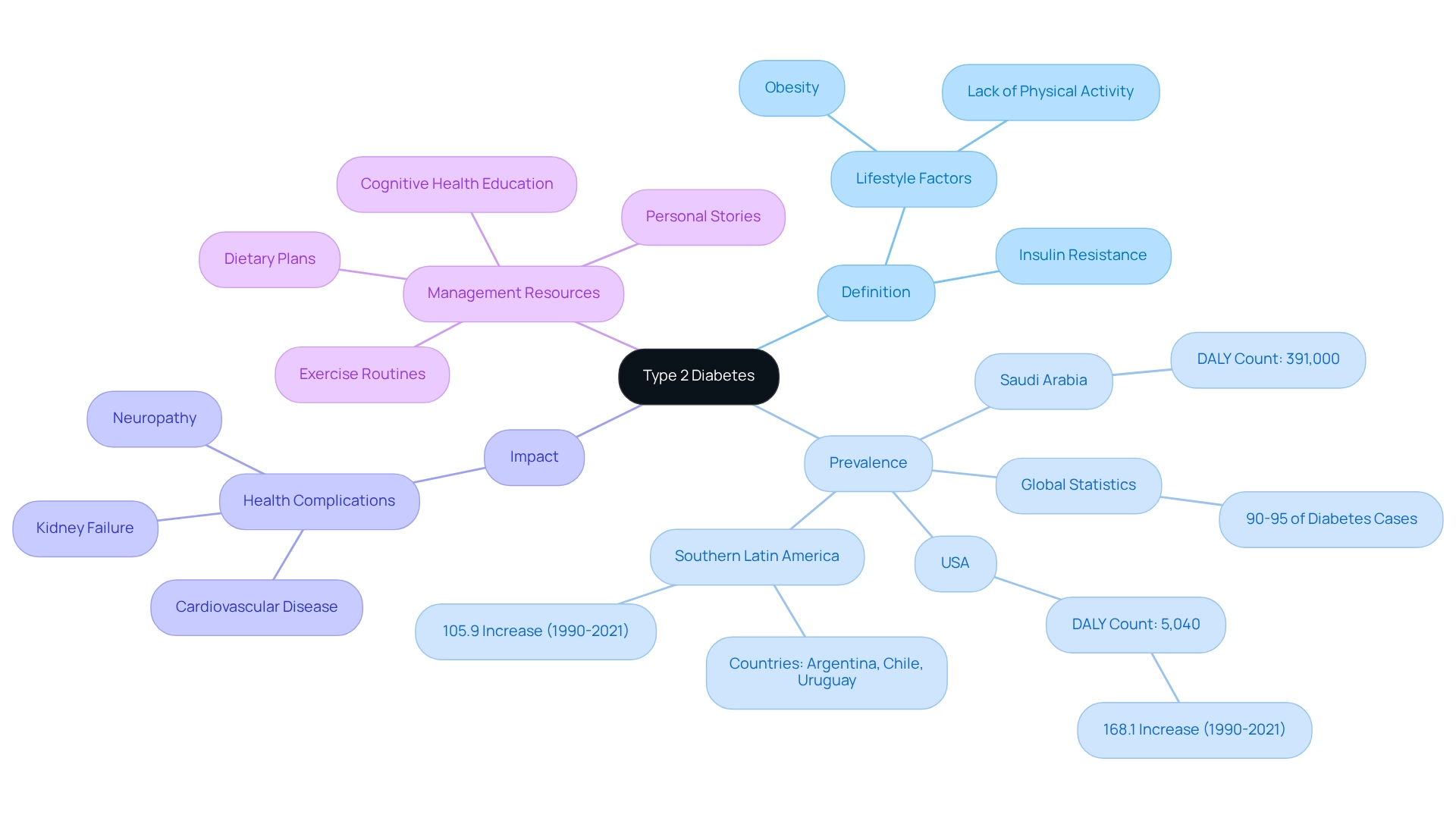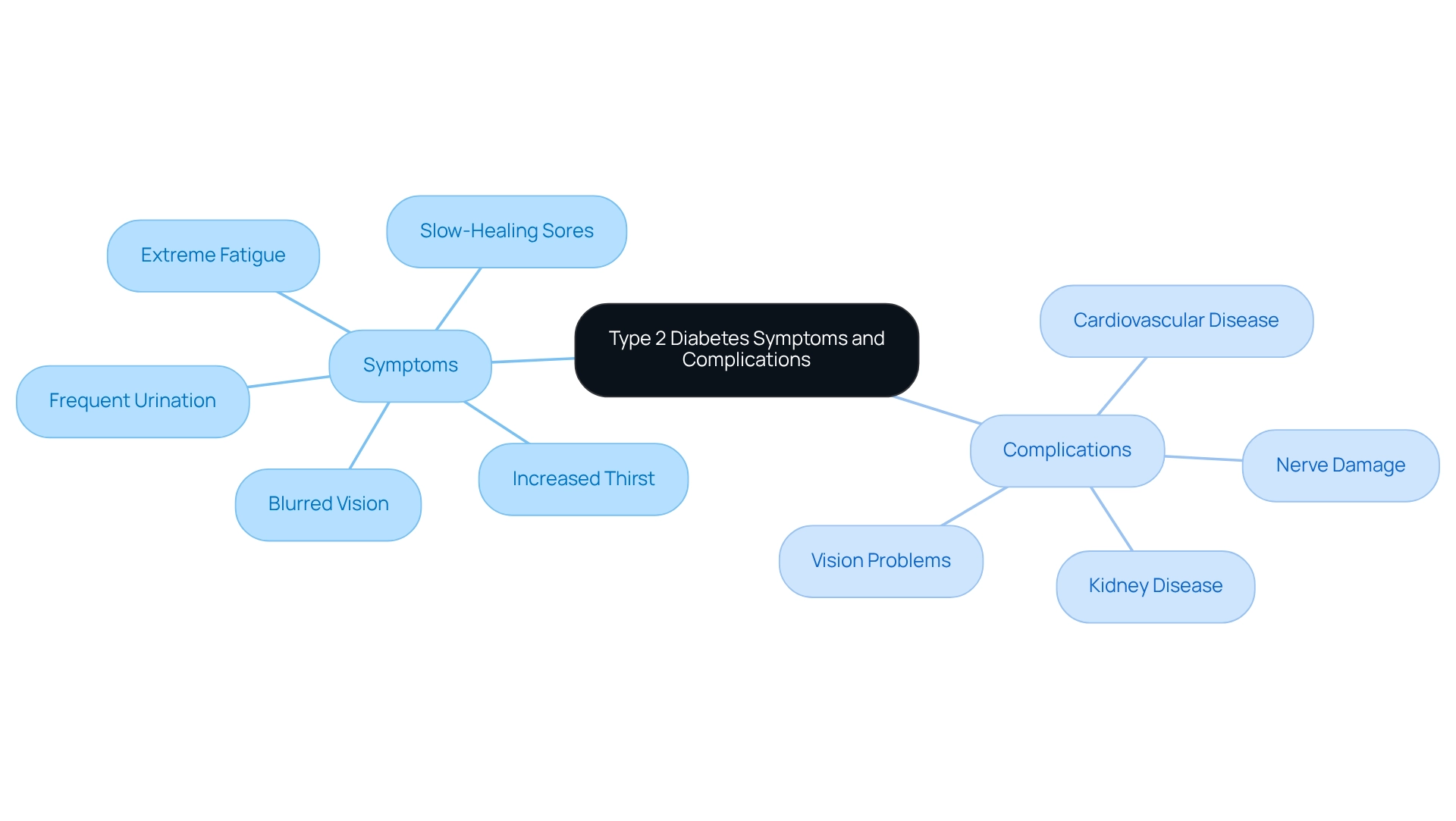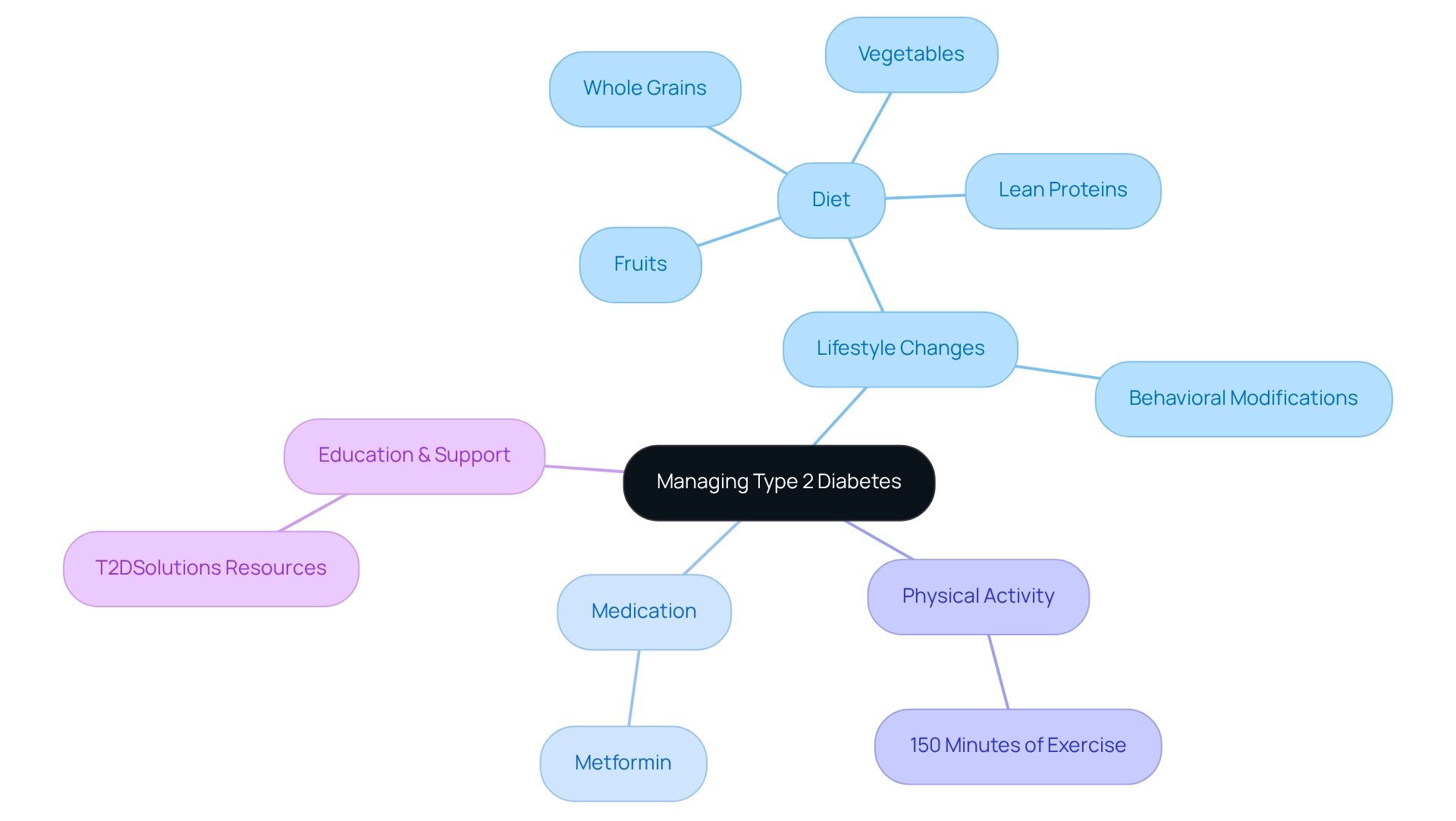Overview
Type 2 diabetes can feel overwhelming, but understanding its causes can empower you. Insulin resistance, often linked to lifestyle factors such as obesity and sedentary behavior, is the primary culprit, and it develops gradually, affecting millions around the world. It's important to recognize that you're not alone in this journey.
Understanding the risk factors and symptoms is crucial. Early intervention through lifestyle changes and education can significantly improve your management of this condition. Remember, taking those first steps can make a world of difference in reducing the risk of serious health complications.
We encourage you to seek support and resources available to you. You're not alone in navigating this path, and there are communities ready to help you every step of the way. Together, we can work toward a healthier future.
Introduction
In a world where chronic health conditions are increasingly prevalent, Type 2 Diabetes emerges as a significant public health challenge, impacting millions globally. This condition, characterized by insulin resistance and often linked to lifestyle choices, transcends personal health issues; it represents a growing epidemic that calls for our urgent attention. As we deepen our understanding of its causes, symptoms, and management strategies, the importance of education and proactive intervention becomes ever more apparent.
It's understandable to feel overwhelmed when facing such a diagnosis. From recognizing the risk factors to implementing effective lifestyle changes, navigating the complexities of Type 2 Diabetes is crucial for enhancing health outcomes and improving quality of life. This article explores the multifaceted nature of Type 2 Diabetes, offering insights and resources designed to empower you on your journey toward better health. Remember, you are not alone in this journey; we are here to support you every step of the way.
Define Type 2 Diabetes: Understanding the Condition
What's diabetes type 2? It is a long-lasting metabolic condition characterized by insulin resistance, meaning the body does not use insulin efficiently, which can lead to increased blood sugar levels. Unlike Type 1 diabetes, primarily an autoimmune issue, Type 2 typically develops gradually and is often linked to lifestyle factors such as obesity and lack of physical activity. This condition is the most common, accounting for around 90-95% of all diabetes cases globally.
At T2DSolutions, we understand the significant impact of Type 2 diabetes worldwide, affecting millions and increasingly prevalent across various populations. For instance, in Saudi Arabia, the burden of this disease is evident, with a Disability-Adjusted Life Year (DALY) count of 391,000. In the USA, the situation is even more striking, with 5,040 DALYs reported, reflecting a 168.1% increase from 1990 to 2021. Southern Latin America has also seen diabetes-related DALYs surge by 105.9% during the same period, highlighting the urgent need for enhanced education and healthcare resources in these areas, particularly in understanding what's diabetes type 2, as unmanaged cases can lead to serious health complications, including cardiovascular disease, kidney failure, and neuropathy. The gradual onset of this condition often allows for early intervention through lifestyle changes, which is why education and awareness are vital for effective management. At T2DSolutions, we are committed to providing clear, actionable, and reliable information tailored to your needs, helping you navigate the complexities of care. We offer a variety of resources, including dietary plans, exercise routines, and personal stories from individuals managing the condition.
Moreover, we shed light on the emerging category 3 condition, which is related to cognitive health, emphasizing the importance of comprehensive diabetes education and support for those affected. Remember, you're not alone in this journey; we are here to support you every step of the way.

Explore Causes and Risk Factors of Type 2 Diabetes
The emergence of what's diabetes type 2 is influenced by a complex interaction of genetic and environmental elements. Among the most significant risk factors is obesity, particularly the accumulation of abdominal fat, which is closely linked to insulin resistance. It's understandable to feel concerned about recent statistics indicating a troubling trend: the prevalence of obesity among adolescents has steadily increased since the late 1980s, highlighting a growing public health concern. Sedentary lifestyles and poor dietary choices further exacerbate this risk, especially for individuals over the age of 45, who are at heightened vulnerability.
At T2DSolutions, we recognize the importance of understanding these risk factors. Family background plays a crucial role; individuals with a parent or sibling diagnosed with what's diabetes type 2 have a higher chance of developing the condition themselves. Additionally, ethnicity influences risk, with specific groups, such as African Americans, Hispanics, and Native Americans, showing greater vulnerability to what's diabetes type 2, while research findings highlight the link between obesity and insulin resistance, demonstrating that as body mass index (BMI) rises, so do the chances of developing what's diabetes type 2. For instance, the World Health Organization has reported an adjusted odds ratio of 3.2 for individuals in the obese I category and 8.1 for those in the obese II category, illustrating the stark correlation between weight and diabetes risk.
Moreover, case studies have identified limitations in current diabetes research, such as small sample sizes and insufficient demographic matching. This indicates a need for further investigation to validate these findings. Understanding these risk factors is crucial for effective prevention and early intervention, empowering individuals to take proactive steps in managing their health. Remember, you're not alone in this journey. T2DSolutions aims to provide resources and support to help newly diagnosed patients navigate these challenges effectively.

Identify Symptoms and Complications of Type 2 Diabetes
Symptoms of what's diabetes type 2 often develop gradually, making early identification challenging. Common signs to look out for include:
- Increased thirst
- Frequent urination
- Extreme fatigue
- Blurred vision
- Slow-healing sores
It’s easy to overlook these indicators, which can lead to delays in diagnosis and treatment. Alarmingly, about 26.4 million adults aged 65 and older have prediabetes, highlighting the need for greater awareness in this group about what's diabetes type 2, as untreated Type 2 diabetes can lead to serious complications, such as:
- Cardiovascular disease
- Nerve damage (neuropathy)
- Kidney disease
- Vision problems like diabetic retinopathy
In 2020 alone, there were 267,000 emergency department visits for hyperglycemic crises among adults with this condition, which underscores the urgent need for better management and education. Statistics show that 8.0% of adults with diagnosed health issues had a non-HDL cholesterol level of 190 mg/dL or higher, indicating a significant risk factor for cardiovascular complications. Furthermore, many individuals with Type 2 Diabetes face complications, making it crucial to monitor symptoms and seek timely medical intervention to understand what's diabetes type 2.
Healthcare providers consistently emphasize the importance of recognizing diabetes-related symptoms early. Proactive management can lead to improved health outcomes. By understanding these symptoms and their potential complications, individuals at risk can take informed steps toward effective management of their condition and an enhanced quality of life.
Remember, you're not alone in this journey. T2DSolutions aims to be a comprehensive resource hub for diabetes education, offering support and information to help you navigate your diabetes journey. We are here to support you every step of the way.

Manage Type 2 Diabetes: Treatment and Lifestyle Strategies
Managing this condition can feel overwhelming, but it’s important to know that a comprehensive strategy can make a significant difference. This includes making changes in habits, medication, and consistently monitoring blood sugar levels. Adopting a balanced diet is essential—think whole grains, fruits, vegetables, and lean proteins—while also reducing processed foods and sugars.
Studies show that behavioral modifications can greatly influence blood sugar management; in fact, among 3,855 participants, these changes were linked to a remarkable 37% decrease in the risk of developing what's diabetes type 2 over a median follow-up of 13 years. Additionally, regular physical activity plays a crucial role as well. Current guidelines recommend at least 150 minutes of moderate exercise each week. This not only helps with weight management but also improves insulin sensitivity. When lifestyle changes alone aren’t enough, medications like Metformin can be an important tool in controlling blood sugar levels.
Continuous education and support from healthcare professionals are vital for successful self-management and avoiding complications. T2DSolutions is a wonderful resource hub for diabetes education and community support, providing access to educational materials, group activities, and professional guidance. By embracing these strategies—lifestyle changes, medication adherence, and ongoing education through T2DSolutions—you can take proactive steps toward managing your condition and enhancing your overall quality of life. Remember, you're not alone in this journey; we are here to support you every step of the way.

Conclusion
Type 2 Diabetes is a complex and multifaceted condition that truly deserves our attention and understanding. This article has explored the nature of the disease, its causes, symptoms, and effective management strategies. The prevalence of Type 2 Diabetes is alarming, with millions affected globally. Recognizing the risk factors—such as obesity, a sedentary lifestyle, and genetic predisposition—is critical for prevention and early intervention.
Symptoms often develop gradually, making awareness essential for timely diagnosis and treatment. It's understandable to feel overwhelmed by the potential complications associated with unmanaged diabetes, including cardiovascular issues and nerve damage. This highlights the urgency for proactive health measures. By implementing lifestyle changes, such as adopting a balanced diet and engaging in regular physical activity, individuals can significantly improve their health outcomes and reduce the risk of further complications.
Education and support are paramount in navigating the complexities of Type 2 Diabetes. Resources provided by organizations like T2DSolutions empower individuals to take charge of their health journey. Remember, you're not alone in this journey. Through informed decision-making and a commitment to lifestyle modifications, it is possible to manage this condition effectively, enhancing quality of life and reducing the burden of diabetes-related complications. The journey may be challenging, but with the right knowledge and support, a healthier future is within reach.
Frequently Asked Questions
What is Type 2 diabetes?
Type 2 diabetes is a long-lasting metabolic condition characterized by insulin resistance, meaning the body does not use insulin efficiently, which can lead to increased blood sugar levels. It typically develops gradually and is often linked to lifestyle factors such as obesity and lack of physical activity.
How common is Type 2 diabetes?
Type 2 diabetes is the most common form of diabetes, accounting for around 90-95% of all diabetes cases globally.
What are the health impacts of Type 2 diabetes?
Unmanaged Type 2 diabetes can lead to serious health complications, including cardiovascular disease, kidney failure, and neuropathy.
What is the significance of education and awareness in managing Type 2 diabetes?
Education and awareness are vital for effective management of Type 2 diabetes, as the gradual onset of the condition allows for early intervention through lifestyle changes.
What resources does T2DSolutions provide for managing Type 2 diabetes?
T2DSolutions offers a variety of resources, including dietary plans, exercise routines, and personal stories from individuals managing the condition.
What is the emerging category 3 condition related to Type 2 diabetes?
The emerging category 3 condition is related to cognitive health, emphasizing the importance of comprehensive diabetes education and support for those affected.
How prevalent is Type 2 diabetes in specific regions?
In Saudi Arabia, the burden of Type 2 diabetes is significant, with a Disability-Adjusted Life Year (DALY) count of 391,000. In the USA, there were 5,040 DALYs reported, reflecting a 168.1% increase from 1990 to 2021. Southern Latin America has also seen a surge of 105.9% in diabetes-related DALYs during the same period.



